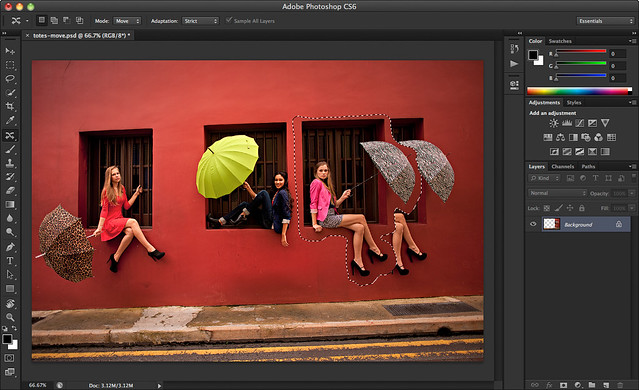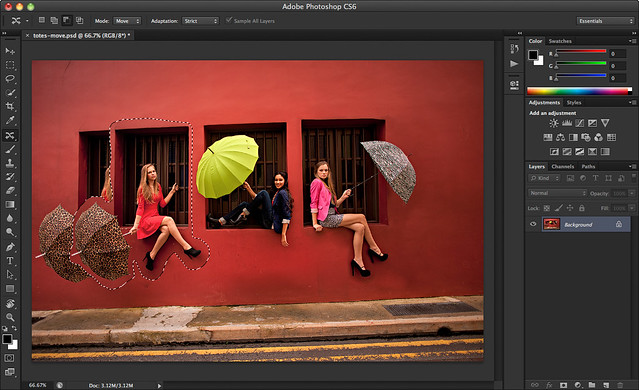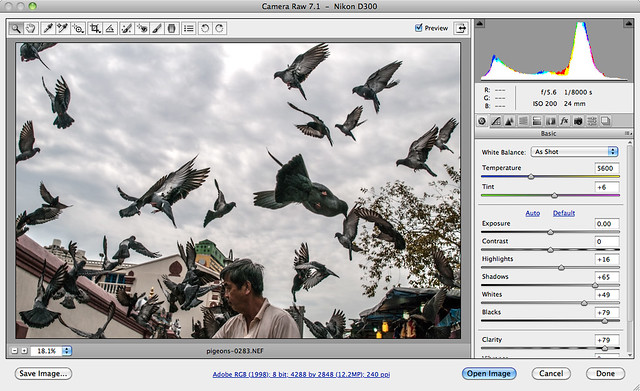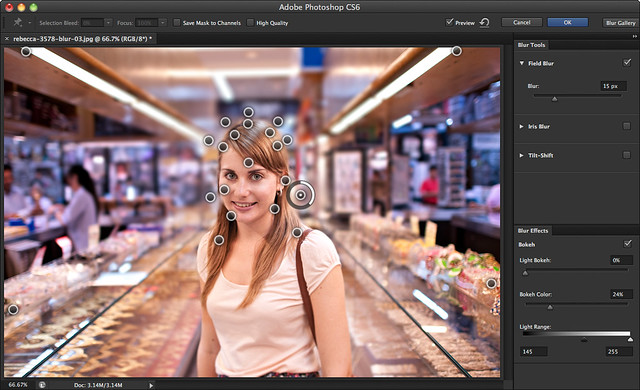I’ve been working as a graphic designer for more than 10 years now, and have been doing photography for about 4… so Photoshop is a staple for me. When Adobe released Photoshop CS6, I was in absolute geek bliss, pretty much how gamers felt like when they got their copy of Diablo III.
So after a couple of weeks using Photoshop CS6, I’d like to show my 3 favorite features. These are the new features which I anticipate I’ll be using a great deal as a photographer:
1) CONTENT-AWARE MOVE
One of the most impressive features in this version is the content-aware move. I shot this photo (below) in a recent project, and I remember the client wanted me to move the girls closer together. With content-aware move, all I have to do was select the object… and well, move.




I have to admit, this was one of the features in my wishlist that I didn’t really expect to materialize. I do have to mention though that it works best on photos with simpler backgrounds. And if you’re one to pixel peep, you will find some warped textures resulting from the move, but this is easily remedied by the heal tool.
2) ADOBE CAMERA RAW 7
I was wandering around an area in Chinatown beside a Hindu temple filled with loitering pigeons… when suddenly, this old man walked in the middle of the street and threw a handful of rice grains. The pigeons went crazy.. and with no regard to my camera’s settings, I just tried to snap as much photos and as quickly as I could. Unfortunately, the photos came out totally under exposed:

Fortunately, with extended controls in Adobe Camera Raw 7.0 on highlights and shadows, I’m able to bring out the details in the shot.

So now you can worry less about getting the exposure right in sudden unexpected situations like this… just focus on composing and capturing the moment.

Oh and yeah, this is the main reason why I prefer shooting in RAW.
3) SELECTIVE BLURRING
I’m not a big fan of simulating bokeh or background blur in photoshop because it never comes out right. But with the new ‘Field Blur’ function, you can select multiple points from an image and dictate the amount of blur or (non-blur) for each point. If you have a good understanding on how bokeh works, with careful analysis, you can simulate better background blur thus making your portrait subject stand out more naturally.
This is a portrait I took on a past client project. For this shot, I used a 24mm lense wide open at f1.4. Although I’m happy with the shot, I sort of wished there was a bit more blur in the background to make the subject stand out more.

I used photoshop CS6’s field blur function to select several points to blur and points to not blur.

This is a preview of the blur mask. Areas in white are in blur, areas in black are not.

Although this is not perfect, and I still prefer bokeh straight out of the camera, it’s nice to know this kind of feature exist in case you’ll need it for some few quick tweaks.

OTHER COOL FEATURES:
The features I listed above are only some of the new features and upgrades in Adobe’s latest Photoshop release. There’s a whole slew of new stuff which I think make this upgrade probably the most significant one so far through the years.
New User Interface – This was the very first thing I noticed… and I instantly fell in love with it. I love the dark background, I think it gives focus to the image in hand.
Adaptive Wide Angle – Another awesome new feature. It’s not a personal fave though, since I don’t do landscapes. But photographers who use an ultra-wide angle or fisheye lens will get a kick out of these. Check this video to see this at work.
New Cropping Workflow – This is another pretty significant upgrade. The previous workflow makes it hard to preview your angled crops… now, they’ve applied the same cropping workflow as with Lightroom. Plus, they introduced the option to not delete the cropped pixels. Which means cropping is not non-destructive! Check this video to see how it works now.
Edit Video – This is not meant to replace video editing software like Adobe Premier or After Effects. In fact, the controls are pretty basic. But I’ve played around with it and it’s a pretty nifty feature for some quick editing. And it’s a good start.
Auto-Save – I’ve been burned so many times for not saving more often than I should. I’ve had my share of recreating complicated digital work because of system failures – auto save is a potential hero.
I have to say CS6 is not yet perfect. Even with the huge step on content-awareness, it still only works best on simpler backgrounds. And the video editing tool is cool, but its functions are pretty basic. It’s a good start though.
I still use Photoshop CS4 in the office at my day job as a graphic designer, and every time I go home to CS6, I can definitely feel the world of difference. Of the years that I’ve used Photoshop, I can say that CS6 is one of the largest leap forward in terms of features and usability. A lot of it’s new features are definitely geared towards making your work faster and easier, allowing you to focus more on creativity.
Wonderful goods from you, man. I have understand your stuff previous to and you’re just too excellent. I actually like what you’ve acquired here, really like what you’re stating and the way in which you say it. You make it entertaining and you still care for to keep it wise. I can’t wait to read far more from you. This is really a wonderful site.
I like what you guys are up also. Such clever work and reporting! Keep up the superb works guys I have incorporated you guys to my blogroll. I think it will improve the value of my website :)
Great blog here! Also your web site loads up very fast! What host are you using? Can I get your affiliate link to your host? I wish my site loaded up as quickly as yours lol
Hiya, I’m really glad I’ve found this info. Nowadays bloggers publish only about gossips and net and this is actually irritating. A good website with exciting content, that’s what I need. Thank you for keeping this site, I’ll be visiting it. Do you do newsletters? Cant find it.
You made some nice points there. I did a search on the subject and found most persons will consent with your blog.
Wonderful goods from you, man. I’ve understand your stuff
previous to and you are just extremely fantastic.
I really like what you have acquired here, certainly
like what you are stating and the way in which you say
it. You make it enjoyable and you still care for to keep it smart.
I cant wait to read far more from you. This is really a great website.
I have a Blogger blog that is hooked up to my personal website. The actual blog is linked off of the homepage. I would like to know if there’s a widget or something that I can put on my website’s homepage that will show my latest blog posts. Not the whole post, but maybe just the headline and a link to go to my blog..
I like what you guys are up also. Such smart work and reporting! Keep up the superb works guys I have incorporated you guys to my blogroll. I think it will improve the value of my site :)
I have been reading out a few of your posts and i can state pretty clever stuff. I will surely bookmark your blog.
I have been exploring for a little bit for any high-quality articles or blog posts on this sort of area . Exploring in Yahoo I finally stumbled upon this site. Reading this information So i¡¦m happy to express that I’ve an incredibly good uncanny feeling I came upon just what I needed. I so much indubitably will make sure to don¡¦t forget this site and give it a glance on a continuing basis.
I know many wikipedia articles contains copyright violation or licence violation. how do i do this..
I simply want to say I am just very new to blogs and honestly savored this blog. More than likely I’m likely to bookmark your site . You really come with really good stories. Kudos for sharing with us your website.
Well I truly enjoyed studying it. This post provided by you is very practical for correct planning.
Thank you a lot for giving everyone remarkably special possiblity to read articles and blog posts from this web site. It is often very terrific plus packed with a great time for me and my office co-workers to search your web site no less than 3 times weekly to learn the new issues you have got. Of course, I’m so always pleased with all the excellent inspiring ideas served by you. Certain 2 areas in this article are honestly the most impressive I have ever had.
Thank you for the auspicious writeup. It in fact was a amusement account it. Look advanced to far added agreeable from you! However, how can we communicate?
Excellent post. I was checking constantly this blog and I’m impressed! Extremely useful information particularly the last part :) I care for such info much. I was looking for this certain info for a very long time. Thank you and best of luck.
Good site! I truly love how it is simple on my eyes and the data are well written. I’m wondering how I could be notified when a new post has been made. I have subscribed to your RSS which must do the trick! Have a great day!
Great post. I was checking constantly this blog and I am impressed! Very useful information specially the last part :) I care for such info much. I was looking for this particular information for a long time. Thank you and best of luck.
I like the helpful info you provide in your articles. I will bookmark your weblog and check again here regularly. I’m quite certain I will learn many new stuff right here! Best of luck for the next!
Very good information. Lucky me I ran across your site by accident (stumbleupon). I’ve saved it for later!
Great awesome issues here. I am very happy to peer your article. Thank you so much and i am taking a look ahead to contact you. Will you kindly drop me a mail?
I’m extremely impressed with your writing skills as well as with the layout on your blog. Is this a paid theme or did you customize it yourself? Either way keep up the excellent quality writing, it’s rare to see a great blog like this one today..
Great ¡V I should definitely pronounce, impressed with your web site. I had no trouble navigating through all tabs as well as related information ended up being truly simple to do to access. I recently found what I hoped for before you know it in the least. Reasonably unusual. Is likely to appreciate it for those who add forums or anything, web site theme . a tones way for your customer to communicate. Nice task..
As I web site possessor I believe the content matter here is rattling great , appreciate it for your hard work. You should keep it up forever! Best of luck.
Lovely site! I am loving it!! Will be back later to read some more. I am bookmarking your feeds also
magnificent post, very informative. I ponder why the opposite experts of this sector do not realize this. You must continue your writing. I am confident, you have a huge readers’ base already!
I intended to put you a very small observation in order to say thanks a lot over again relating to the extraordinary techniques you have provided here. This has been quite unbelievably open-handed of you to provide openly just what a lot of people might have distributed as an e book to make some money for their own end, most notably since you might well have done it in case you desired. These concepts in addition acted as a great way to fully grasp that other individuals have the identical zeal really like my own to know the truth more and more concerning this condition. I believe there are many more pleasurable opportunities ahead for individuals who scan through your blog post.
I was recommended this blog by my cousin. I’m not sure whether this post is written by him as nobody else know such detailed about my difficulty. You’re wonderful! Thanks!
hi!,I love your writing so so much! share we keep in touch more approximately your post on AOL? I need an expert in this house to unravel my problem. Maybe that is you! Looking forward to peer you.
What i don’t realize is in reality how you are not really a lot more neatly-liked than you may be now. You’re very intelligent. You realize therefore considerably when it comes to this topic, made me personally consider it from numerous numerous angles. Its like women and men are not fascinated until it¡¦s one thing to accomplish with Lady gaga! Your personal stuffs outstanding. All the time take care of it up!
My brother suggested I might like this blog. He was totally right. This post actually made my day. You cann’t imagine simply how much time I had spent for this info! Thanks!
Thanks a bunch for sharing this with all people you really recognize what you’re talking about! Bookmarked. Kindly additionally visit my site =). We may have a link change contract among us!